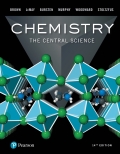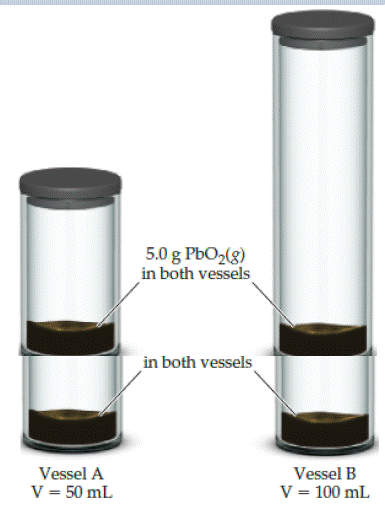
EBK CHEMISTRY:CENTRAL SCIENCE
14th Edition
ISBN: 9780134554570
Author: Brown
Publisher: PEARSON
expand_more
expand_more
format_list_bulleted
Textbook Question
Chapter 15, Problem 7E
When lead(IV) oxide is heated above 300 O C, it decomposes according to the following reaction PbO2(s) ⇌ PbO(s) + O2(g). Consider the two sealed vessels of PBO2 shown here. If both vessels are heated to 400 O C and allowed to come to equilibrium, which of the following statements is true?
- There will be less PbO2 remaining in vessel A,
- There will be less PbO2 remaining in vessel B,
- The amount of PbO2 remaining in each vessel will be the same.
[Section 15.4]

Expert Solution & Answer
Want to see the full answer?
Check out a sample textbook solution
Students have asked these similar questions
An essential part of the experimental design process is to select appropriate dependent and
independent variables.
True
False
10.00 g of Compound X with molecular formula C₂Hg are burned in a constant-pressure calorimeter containing 40.00 kg of water at 25 °C. The temperature of
the water is observed to rise by 2.604 °C. (You may assume all the heat released by the reaction is absorbed by the water, and none by the calorimeter itself.)
Calculate the standard heat of formation of Compound X at 25 °C.
Be sure your answer has a unit symbol, if necessary, and round it to the correct number of significant digits.
need help not sure what am doing wrong step by step please answer is 971A
During the lecture, we calculated the Debye length at physiological salt concentrations and temperature, i.e. at an ionic strength of 150 mM (i.e. 0.150 mol/l) and a temperature of T=310 K. We predicted that electrostatic interactions are effectively screened beyond distances of 8.1 Å in solutions with a physiological salt concentration.
What is the Debye length in a sample of distilled water with an ionic strength of 10.0 µM (i.e. 1.00 * 10-5 mol/l)? Assume room temperature, i.e. T= 298 K, and provide your answer as a numerical expression with 3 significant figures in Å (1 Å = 10-10 m).
Chapter 15 Solutions
EBK CHEMISTRY:CENTRAL SCIENCE
Ch. 15.2 - Prob. 15.1.1PECh. 15.2 - Prob. 15.1.2PECh. 15.2 - Prob. 15.2.1PECh. 15.2 - Prob. 15.2.2PECh. 15.3 - Prob. 15.3.1PECh. 15.3 - Practice Exercise 2 For the reaction H2 (g) + I2...Ch. 15.3 - Prob. 15.4.1PECh. 15.3 - Prob. 15.4.2PECh. 15.4 - Prob. 15.5.1PECh. 15.4 - Prob. 15.5.2PE
Ch. 15.4 - Practice Exercise 1
If 8.0 g of NH4HS(s)...Ch. 15.4 - Prob. 15.6.2PECh. 15.5 - Practice Exercise 1
A mixture of gaseous sulfur...Ch. 15.5 - Prob. 15.7.2PECh. 15.5 - Practice Exercise 1 In Section 15.1, we discussed...Ch. 15.5 - Practice Exercise 2
The gaseous compound BrCl...Ch. 15.6 - Prob. 15.9.1PECh. 15.6 - Practice Exercise 2 At 1000 k, the value of Kp for...Ch. 15.6 - Prob. 15.10.1PECh. 15.6 - Prob. 15.10.2PECh. 15.6 - Practice Exercise 1 For the equilibrium Br2(g) +...Ch. 15.6 - Prob. 15.11.2PECh. 15.7 - Practice Exercise 1 For the reaction 4 NH3(g) + 5...Ch. 15.7 - Prob. 15.12.2PECh. 15 - Prob. 1DECh. 15 - Based on the following energy profile, predict...Ch. 15 - 15.2 The following diagrams represent a...Ch. 15 - Prob. 3ECh. 15 - Prob. 4ECh. 15 - Prob. 5ECh. 15 - 15.6 Ethene (C2H4) reacts with healogens (X2) by...Ch. 15 - When lead(IV) oxide is heated above 300 O C, it...Ch. 15 - Prob. 8ECh. 15 - The reactin A2(g) + B(g) + A(g) + AB(g) has an...Ch. 15 - Prob. 10ECh. 15 - Prob. 11ECh. 15 - The following graph represents the yield of the...Ch. 15 - Suppose that the gas-phase reactions A B and B A...Ch. 15 - Prob. 14ECh. 15 - Prob. 15ECh. 15 - Write the expression for KC for the following...Ch. 15 - When the following reaction come to equilibrium,...Ch. 15 - Prob. 18ECh. 15 - Prob. 19ECh. 15 - Prob. 20ECh. 15 - If Kc = 0.042 for PC13(g) + C12 (g) PC15 (g) at...Ch. 15 - Prob. 22ECh. 15 - 15.23 The equilibrium constant for the...Ch. 15 - Prob. 24ECh. 15 - Prob. 25ECh. 15 - Prob. 26ECh. 15 - The following equilibria were attained at 823 K:...Ch. 15 - Consider the equilibrium N2(g) + O2(g) + Br2(g) 2...Ch. 15 - Mercury(I) oxide decomposes into elemental mercury...Ch. 15 - Prob. 30ECh. 15 - Prob. 31ECh. 15 - Prob. 32ECh. 15 - Prob. 33ECh. 15 - Phosphorus trichloride gas and chlorine gas react...Ch. 15 - A mixture of 0.10 mol of NO, 0.050 mol of H2, and...Ch. 15 - Prob. 36ECh. 15 - A mixture of 0.2000 mol of CO2, 0.1000 mol of H2,...Ch. 15 - 15.38 A flask is charged with 1.500 atm of N2O4(g)...Ch. 15 - Prob. 39ECh. 15 - Prob. 40ECh. 15 - a. If QC KC, in which direction will a reaction...Ch. 15 - Prob. 42ECh. 15 - At 100 OC , the equilibrium constant for the...Ch. 15 - 15.44 As shown in Table 15.2, KP for the...Ch. 15 - At 100 C, K = 0.078 for the reaction SO2Cl2 (g) ...Ch. 15 - Prob. 46ECh. 15 - Prob. 47ECh. 15 - Prob. 48ECh. 15 - At 800 k, the equilibrium constant for I2 (g) ...Ch. 15 - Prob. 50ECh. 15 - At 2000 OC, the equilibrium constant for the...Ch. 15 - For the equilibrium Br2 (g) + Cl2 (g) 2BrCl(g) At...Ch. 15 - At 373 k, Kp = 0.416 for the equilibrium 2NOBr (g)...Ch. 15 - At 218 oC, KC= 1.2 X 10-4 for the equilibrium NH4...Ch. 15 - Prob. 55ECh. 15 - At 80 oC, K =1.87 X 10-3 for the reaction PH3 BCl3...Ch. 15 - Prob. 57ECh. 15 - Prob. 58ECh. 15 - Prob. 59ECh. 15 - Prob. 60ECh. 15 - Consider the following equilibrium for which H<0...Ch. 15 - Prob. 62ECh. 15 - 15.63 How do the following changes affect the...Ch. 15 - Prob. 64ECh. 15 - Consider the following equilibrium between oxides...Ch. 15 - Prob. 66ECh. 15 - Ozone, O3, decomposes to molecular oxygen in the...Ch. 15 - Prob. 68ECh. 15 - Prob. 69ECh. 15 - 15.70 True or false: When the temperature of an...Ch. 15 - Prob. 71AECh. 15 - Prob. 72AECh. 15 - 15.73 A mixture of CH4 and H2O is passed over a...Ch. 15 - Prob. 74AECh. 15 - Prob. 75AECh. 15 - Prob. 76AECh. 15 - Prob. 77AECh. 15 - Prob. 78AECh. 15 - Prob. 79AECh. 15 - For the equilibrium PH3BCI3 (s) PH3 (g) + BCI3...Ch. 15 - Prob. 81AECh. 15 - Prob. 82AECh. 15 - Prob. 83AECh. 15 - At 900 o C, Kc = 0.0108 for the reaction CaCO3(g) ...Ch. 15 - Prob. 85AECh. 15 - The equilibrium constant Kc for C(s) +CO2 2CO(g)...Ch. 15 - Prob. 87AECh. 15 - Le Chatelier noted that many industrial processes...Ch. 15 - Prob. 89AECh. 15 - Prob. 90AECh. 15 - [15.91] An equilibrium mixture of H2, I2, and HI...Ch. 15 - Consider the hypothetical reaction A(g) + 2B(g) 2...Ch. 15 - Prob. 93AECh. 15 - Prob. 94AECh. 15 - Prob. 95IECh. 15 - The following equilibria were measured at 823 K:...Ch. 15 - Prob. 97IECh. 15 - Prob. 98IECh. 15 - At 800 K, the equilibrium constant for the...Ch. 15 - Prob. 100IECh. 15 - Prob. 101IECh. 15 - Prob. 102IE
Knowledge Booster
Learn more about
Need a deep-dive on the concept behind this application? Look no further. Learn more about this topic, chemistry and related others by exploring similar questions and additional content below.Similar questions
- Influence of salt concentrations on electrostatic interactions 2 Answer is 2.17A why not sure step by step please What is the Debye length in a concentrated salt solution with an ionic strength of 2.00 mol/l? Assume room temperature, i.e. T= 298 K, and provide your answer as a numerical expression with 3 significant figures in Å (1 Å = 10-10 m).arrow_forwardThe name of the following molecule is: Νarrow_forwardThe table shows the tensile stress-strain values obtained for various hypothetical metals. Based on this, indicate which is the most brittle and which is the most tough (or most resistant). Breaking strength Elastic modulus Material Yield strength Tensile strength Breaking strain A (MPa) 415 (MPa) (MPa) (GPa) 550 0.15 500 310 B 700 850 0.15 720 300 C Non-effluence fracture 650 350arrow_forward
- Please correct answer and don't used hand raitingarrow_forwardThe table shows the tensile stress-strain values obtained for various hypothetical metals. Based on this, indicate which material will be the most ductile and which the most brittle. Material Yield strength Tensile strength Breaking strain Breaking strength Elastic modulus (MPa) (MPa) (MPa) (GPa) A 310 340 0.23 265 210 B 100 120 0.40 105 150 с 415 550 0.15 500 310 D 700 850 0.14 720 210 E - Non-effluence fracture 650 350arrow_forwardPlease correct answer and don't used hand raitingarrow_forward
arrow_back_ios
SEE MORE QUESTIONS
arrow_forward_ios
Recommended textbooks for you
 Chemistry: The Molecular ScienceChemistryISBN:9781285199047Author:John W. Moore, Conrad L. StanitskiPublisher:Cengage Learning
Chemistry: The Molecular ScienceChemistryISBN:9781285199047Author:John W. Moore, Conrad L. StanitskiPublisher:Cengage Learning Chemistry & Chemical ReactivityChemistryISBN:9781337399074Author:John C. Kotz, Paul M. Treichel, John Townsend, David TreichelPublisher:Cengage Learning
Chemistry & Chemical ReactivityChemistryISBN:9781337399074Author:John C. Kotz, Paul M. Treichel, John Townsend, David TreichelPublisher:Cengage Learning General Chemistry - Standalone book (MindTap Cour...ChemistryISBN:9781305580343Author:Steven D. Gammon, Ebbing, Darrell Ebbing, Steven D., Darrell; Gammon, Darrell Ebbing; Steven D. Gammon, Darrell D.; Gammon, Ebbing; Steven D. Gammon; DarrellPublisher:Cengage Learning
General Chemistry - Standalone book (MindTap Cour...ChemistryISBN:9781305580343Author:Steven D. Gammon, Ebbing, Darrell Ebbing, Steven D., Darrell; Gammon, Darrell Ebbing; Steven D. Gammon, Darrell D.; Gammon, Ebbing; Steven D. Gammon; DarrellPublisher:Cengage Learning Chemistry & Chemical ReactivityChemistryISBN:9781133949640Author:John C. Kotz, Paul M. Treichel, John Townsend, David TreichelPublisher:Cengage Learning
Chemistry & Chemical ReactivityChemistryISBN:9781133949640Author:John C. Kotz, Paul M. Treichel, John Townsend, David TreichelPublisher:Cengage Learning Chemistry: Principles and PracticeChemistryISBN:9780534420123Author:Daniel L. Reger, Scott R. Goode, David W. Ball, Edward MercerPublisher:Cengage Learning
Chemistry: Principles and PracticeChemistryISBN:9780534420123Author:Daniel L. Reger, Scott R. Goode, David W. Ball, Edward MercerPublisher:Cengage Learning ChemistryChemistryISBN:9781305957404Author:Steven S. Zumdahl, Susan A. Zumdahl, Donald J. DeCostePublisher:Cengage Learning
ChemistryChemistryISBN:9781305957404Author:Steven S. Zumdahl, Susan A. Zumdahl, Donald J. DeCostePublisher:Cengage Learning

Chemistry: The Molecular Science
Chemistry
ISBN:9781285199047
Author:John W. Moore, Conrad L. Stanitski
Publisher:Cengage Learning

Chemistry & Chemical Reactivity
Chemistry
ISBN:9781337399074
Author:John C. Kotz, Paul M. Treichel, John Townsend, David Treichel
Publisher:Cengage Learning

General Chemistry - Standalone book (MindTap Cour...
Chemistry
ISBN:9781305580343
Author:Steven D. Gammon, Ebbing, Darrell Ebbing, Steven D., Darrell; Gammon, Darrell Ebbing; Steven D. Gammon, Darrell D.; Gammon, Ebbing; Steven D. Gammon; Darrell
Publisher:Cengage Learning

Chemistry & Chemical Reactivity
Chemistry
ISBN:9781133949640
Author:John C. Kotz, Paul M. Treichel, John Townsend, David Treichel
Publisher:Cengage Learning

Chemistry: Principles and Practice
Chemistry
ISBN:9780534420123
Author:Daniel L. Reger, Scott R. Goode, David W. Ball, Edward Mercer
Publisher:Cengage Learning

Chemistry
Chemistry
ISBN:9781305957404
Author:Steven S. Zumdahl, Susan A. Zumdahl, Donald J. DeCoste
Publisher:Cengage Learning
Chemical Equilibria and Reaction Quotients; Author: Professor Dave Explains;https://www.youtube.com/watch?v=1GiZzCzmO5Q;License: Standard YouTube License, CC-BY